Dindga McCannon, Women in Jazz Saturday, 2020. Phillips X Presents: Dindga McCannon.
A founding member of the Weusi and Where We At artist collectives, an author, costume designer, printmaker, muralist, and studio artist, Dindga McCannon has spent the past several decades poetically unifying different media and stories. She has combined traditional quilting techniques with the fine arts, and she has bridged histories, shining light on those lost to the past. Her work honors the women who she says opened the door for her; it also pushes that door open still further for others.
To coincide with the selling exhibition, Phillips X Presents: Dindga McCannon, we invited legendary curator Lowery Sims to speak with McCannon about her recent work, generating a broader conversation about experimental techniques, heritage, music, dance, activism, and the pursuit of artistic freedom.

Lowery Sims: Could you start by telling me how Where We At started?
Dindga McCannon: At age 16, I volunteered for the Red Cross, and the director had seen the Weusi in an exhibition at the St. Nicholas projects on 127th Street, and he suggested that I go over there. So of course, that next Saturday, I was right there. And basically, I kind of stayed. At the time, Weusi, it was a cultural movement. There were at least 50—maybe more—artists to my recollection.
The next year, there was an ideological split. Weusi became Weusi, the other groups became the Twentieth Century Art Creators. So I stayed with Weusi until I was about 20. And at that time, I became a mom. Being a mother, as an artist, presented a whole new set of challenges. I also was having trouble navigating the art world, because a lot of the galleries that I had approached said, “You are not here for the long haul, you're just going to do this and then you're going to go off.” They didn't really take me seriously; that's what it boils down to.
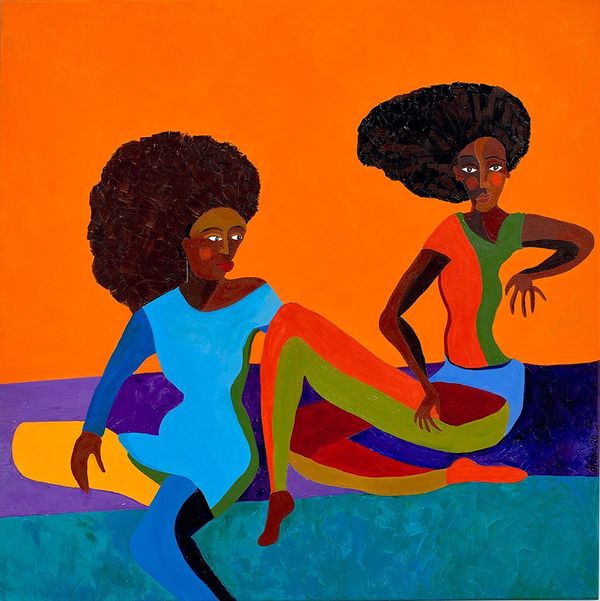
Dindga McCannon, Sisters, 2020. Phillips X Presents: Dindga McCannon.
After a while, I felt a little isolated, because I love my brothers, but there were issues that pertained to me that they didn't have. So one day, I got to talking with Kay Brown, and we called Faith Ringgold and we all said, "Why don't we get a group of women together and just start some kind of conversation?" So Kay, Faith, and I called anybody that we could find. A lot of times when we called people they said, "We don't know any Black women artists other than you.”
However, the first meeting was at my house, my studio in the Lower East Side, and maybe 10 women showed up. These were women of courage because I lived in a fifth floor walk-up, there was water dripping in the hallway, the lights were out. But the women came anyhow. And from that first session, we decided it was great that we were together. And we said, okay, now we need to find a place to exhibit.
At the time, I had had an exhibition at Nigel Jackson's gallery, Acts of Art. I had gotten in there because Ellsworth Ausby had went to bat for me and told Nigel that I was an artist who was here to stay. And so I decided since I got in, let me go over there and see if we can get in and we all went to talk to him. And he thought it was a great idea. Therefore, we ended up having our first art exhibition. I think that was 1971. And that's basically how Where We At started.
As you know, we stayed together for 25 years. We had women of diverse expertise, some of whom were excellent businesswomen. As a result we became a 501c3 organization. We were able to get grants so our members could teach in shelters, prisons, and schools. We were also able to do a mural at 24 Furman Avenue in Brooklyn that was 6 ft by 100 ft.
Our battles were with the outside world and to make our position as Black woman artists viable.
LS: That's pretty amazing. I'm thinking about the timing of Where We At and how it coincided with strains of the feminist art movement. Were there similar kinds of ideological and polemical ideas about what your work should be about? Or was it more of an individual approach, where you would work together mostly for logistics or supporting each other?
DM: I think it was parts of both. We had separate issues because our primary issue was racism. Feminism did not have that. And it seemed at the time that the feminist artists to us were middle class white women who were doing art and had husbands who did or did not support their art and the battle began basically at home. Our battles were with the outside world and to make our position as Black woman artists viable. We have the right to exist; we have the right to express ourselves. Although most of our art was Afrocentric-focused, that was not a demand: you existed as artists. Whatever your art form was, that's what you did. Afrocentric? Wonderful. Other art forms? You were also welcome.
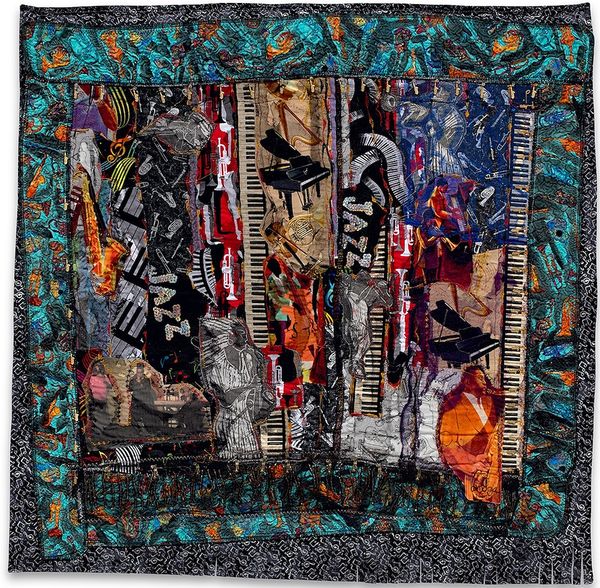
Dindga McCannon, Tribute to Instruments, 2020. Phillips X Presents: Dindga McCannon.
LS: I was surprised when I got the checklist of the show for Phillips—and this is a dereliction on my part—that you had gotten so involved in fiber work. And it's interesting because I'm down here in Baltimore, and Leslie King-Hammond, formerly of MICA, got me involved in a collaborative quilting group that is run by Susie Brandt, who's one of the professors at MICA. All of a sudden me, Lowery Sims, lifelong art historian, is channeling the quilting genes of her grandmother and aunt. But there are so many artists, male and female, who are using fiber techniques, quilting techniques, weaving techniques. Tell me about how you evolved in from painting into working in fabrics. And then I see in your recent show, you've gone back to painting a little bit, too.
DM: Throughout my career, I've kind of refused to be known as a quilter—only because I didn't want to be pigeonholed. Because my art forms, as you know, they continue to evolve and change and add and subtract. I would rather be known as a multimedia, mixed media artist
I actually started two ways. When Kay Brown's mother had died, Kay gave me a bunch of items from her mother's life, and she wanted me to make something visual from them. I think that was one of my first quilts. I also used to make backdrops for some reggae artists. I was painting, printmaking, mural making, writing, and illustrating. Over time, the fact that you had to transport your art became an issue because I did not drive. I still don't drive I have no plans on driving. So I needed a form that was more fluid. So I started doing my work on fabric.
Also, I found that as time went by, all of the mediums that I was dealing with—the printmaking, the drawing, the painting—I could put into what I described as “art quilting.” That meant I had a medium where there were no holds barred, I could use anything, and I do. And that was how I became known as a quilt artist.
One of the ways I've supported myself over the years is wearable art, and most of it has dealt with me painting on a fabric or silk screening. The last dress I designed was fully painted with figures. i asked myself "Why am I not putting these images on canvas? This feels too much like a painting," and I began to paint large again on canvas. Over the years I have been working on a small-sized series The Harlem Women Series. I'm currently up to about 30, maybe 40—I lost count.
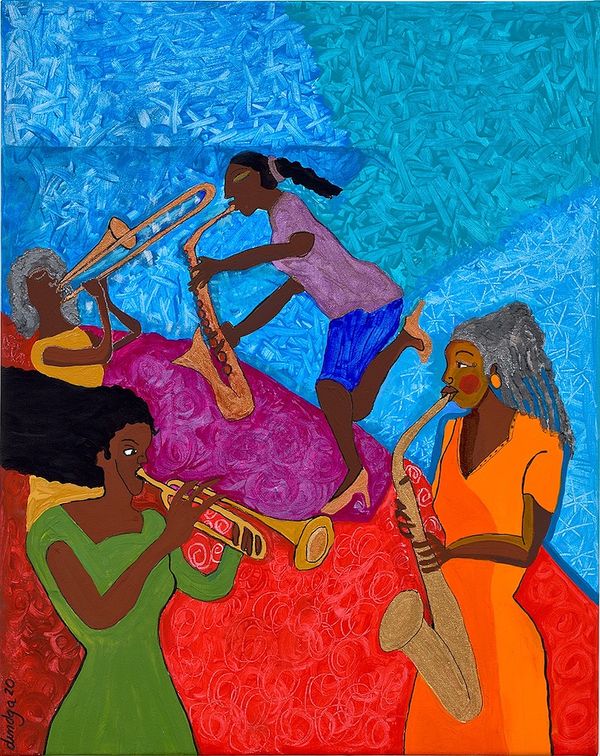
Dindga McCannon, The Horn Section #2, 2020. Phillips X Presents: Dindga McCannon.
LS: Could you tell me more about returning to painting?
DM: After my work sold at the Swann auction, a man came to my house to buy a quilt. And while he was at my studio, and he was talking about, “Oh, I see that this painting sold blah blah blah blah.” And he offered me what I consider slave wages, to do a 50 x 60 painting. I really needed money at that time, but I wasn't working for money that wasn't enough. Oddly enough, a week after that, somebody called out of the blue to commission two paintings. I mean, they wanted me to do them in oil. I said, “Okay, this is the job.” I hadn't done an oil painting for years. But I said, I'm a painter, I can do that. So I started using oil and because I hadn't painted in so long, I didn't really realize how I missed it.
And I fell in love with the whole medium again. Now I'm doing my fiber art in the basement, and I just got a studio space where I have room and light to paint. And so I have reincarnated myself. I'm just shifting my focus. I am working towards a one woman show September 21 at the Fridman Gallery. I want to surprise everyone with the variety of media. Because people often try to put me into a category. And I'm continuously fighting against them. Because I want freedom. I want to be free to do whatever artistic medium I want to do it the moment.
I want to be free to do whatever artistic medium I want to do it the moment.
LS: So tell me, when you started quilting, did you just jump into it? I mean did you have people who taught you? Did you take courses?
DM: I'm basically self-taught. I've taken quite a number of workshops and classes, not about quilting, but about mixed media. And over the years, it kind of took over, and I became the quilt artist.
LS: Do you do hand stitching or machine stitching?
DM: Machine stitching because frankly, if I did hand stitching I'd never finish anything. I went to a quilt show in 2000, and I saw one of those electronic embroidery machines. I looked at it just like a mechanic would buy a better tool. Or a tool that you could use in a lot of different ways. And it was all over once I got that first one.
Even though I don’t hand stich the entire quilt, I'm very fond of hand beading. I love the visual effect of hand stitching. There is something that is so spiritual about it because there's work made by human hand. It has a certain energy. So I do add that to the quilt.
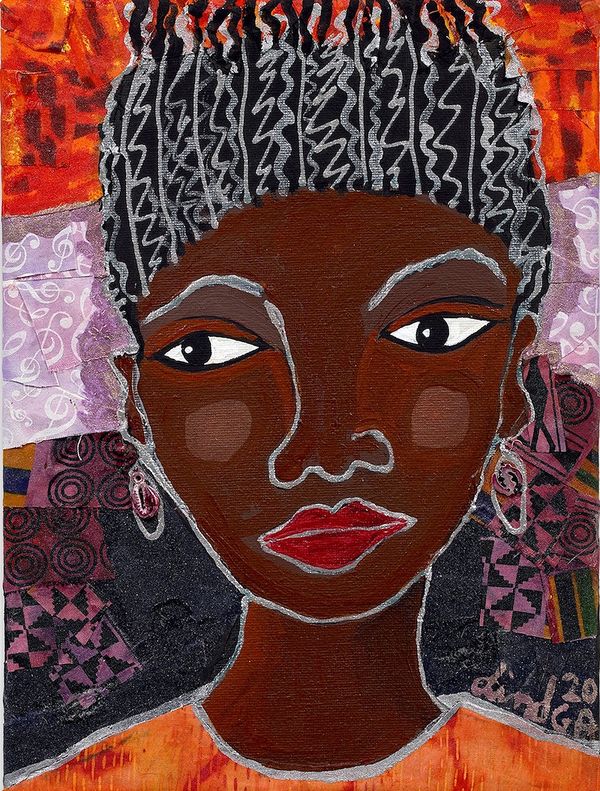
Dindga McCannon, Mariam (Harlem Women's series), 2020. Phillips X Presents: Dindga McCannon.
LS: I wanted to bounce back a bit because I was interested to see that you went to the Art Students League. Over the years, as I've researched artists, it has surprised me how many African American artists went to the Art Students League, even at a moment where the art world would not have recognized their presence in many ways. So why don't you talk about the impact it had on you?
DM: Oh, I worked with the very best. First of all, I came to the Art Students League, because I was very frustrated with academia. I was at City College, and when I would take workshops, the teacher would wonder, why are you painting Black people? And sometimes it would lead to arguments, and I was very offended, because why shouldn't I be painting Black people? Chinese people paint Chinese people, Muslim paint Muslim people, white people paint white people. So why should I be stuck painting white people?
I didn't want to paint white people; I wanted to paint Black people. So I decided that I wasn't getting anywhere with college, and I found that Art Students League where you could go month by month, which meant I could afford it. And you could choose your instructor: Jacob Lawrence, Charles Alston, Richard Mayhew.
Because I was able to get into their workshops, I was able to work with people who understood what I was trying to do. Even though I was a student at the time, they got me. And it wasn't a problem if the models were white, and I was painting them green. They understood what I was trying to do and supported that. I stayed there for two or three years, and then I moved on to the Robert Blackburn Printmaking Workshop.
I've never stopped learning. I've never stopped taking classes that I found interesting and that I thought would expand my repertoire. The Art Students League really was a big part of that, but I also credit my art education to the days with the Weusi because when I met them, I was basically a kid who just loved art. And they gave me the tools I needed to start my career as an artist. The Weusi taught me how to oil paint, how to stretch a canvas, how to frame a canvas, so they gave me a foundation.
LS: Did you grow up in Harlem?
DM: I was born on what they called Welfare Island because they didn't have enough room for me that night at Harlem Hospital. Born and raised in Harlem for most of my young adult life, and then we moved to the Bronx. I still claim to be a Harlemite even though I've been in Philadelphia for the last seven years. I still hold on to my heritage. I'm a Harlem woman.
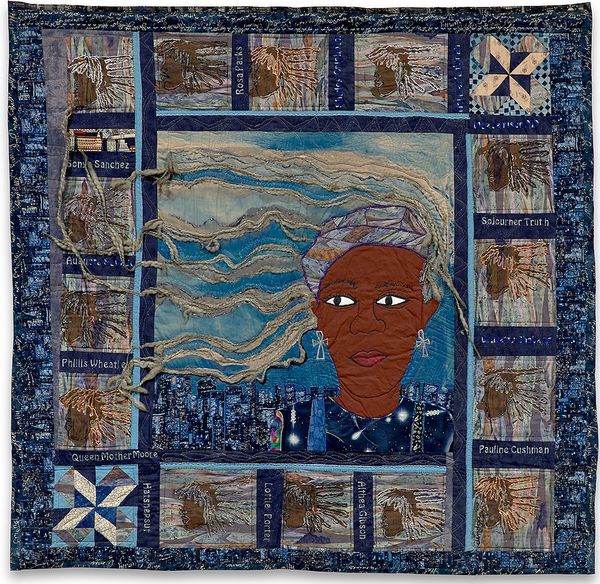
Dindga McCannon, Threads of the Past, Inspiration for the Future, 2020. Phillips X Presents: Dindga McCannon.
LS: I really relate to your resistance to being pigeonholed as a quilt artist back in the day. Today I don’t think it’s a problem. When I first brought "Street Story Quilt" by Faith Rinngold into The Met, it was catalogued as part of the Decorative Arts and Textiles section. I said, “Whoa, whoa, whoa, this is not a quilt. It's a painting that uses quilt techniques.” I told my colleagues, “Just because you roll it up, doesn't mean it's not a painting, dammit.” But it was one of those moments where you realize the institutional practice had to catch up with what the artist was doing.
Let's talk a bit about your "Threads of the Past, Inspiration for the Future." You have the figure and have the skylight and then all these evocations of powerful women from the past and present and this emphasis on hair. I didn't know if you wanted to say anything specific about this one?
DM: I created this piece because every once in a while, I get a little bit discouraged. When those moments occur, I think back to what other women have been able to accomplish under the worst circumstances possible. And when I think about that, it allows me to get out of the depression and move forward. The woman in the center is probably myself. At that time, I had a lot of hair. You know, I had locks, which was another issue.
Surrounding me are women who had done things in different fields, who had managed to push through. And that's why it's threads to the past: things that happened in the past, people who were in the past, that allow me to be inspired to keep going on. So that is a future. And because I'm able to do that, this should apply for other women and other people who take a position in life like being an artist, when you're not always encouraged.
And sometimes you have very dark days and definitely some hungry ones. But just to be reminded of what these women did when Black people weren't even allowed to read or write or had huge economic challenges. And they managed to overcome. Here I am in the 21st century, according to the way that I look at their lives and my life, my life should be a piece of cake. Because they really went through hell to accomplish whatever they accomplished.
I think back to what other women have been able to accomplish under the worst circumstances possible.
LS: Also looking at this, do you tend to lay out the bits of fabric before you start to sew, so you can see your compositions? Or does it evolve as you’re making it?
DM: I kind of work with a basic idea. There are some artists who have the talent to sit down and plan out every square inch. I find that extremely boring. If I knew what something was going to look like before I started, I probably wouldn't start it because the joy and excitement for me is being able to figure it out—and to make something beautiful out of all these little parts. I start with: how am I going to convey an idea to my audience? Then I start putting things together. And it's mostly an intuitive process. With the quilt that you're talking about, I probably started with the major image. And then those women that surround it above the title, that's a silk screen, and I decided, well, this is a screen of women, this would work, printed that out, and then laid it out. And then lastly, machine embroidered the name.
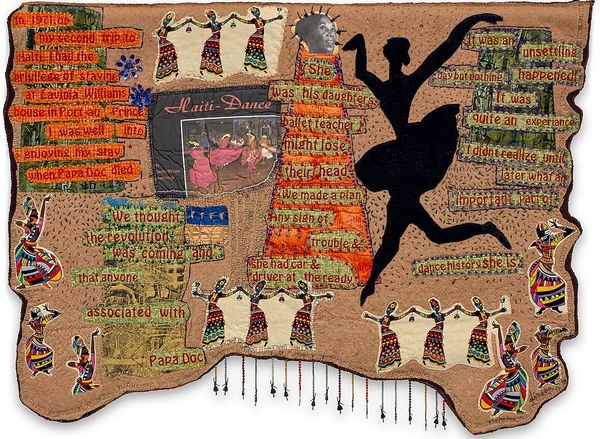
Dindga McCannon, Lavinia Williams, Legendary Dancer, Choreographer, and Teacher, 2020. Phillips X Presents: Dindga McCannon.
LS: I also love the one about Lavinia Williams. What made you decide to have a shape that looks like rawhide?
DM: As I began to work on the piece, the shape just kind of evolved. I thought, “Well, why does it have to be square anyway?” It's more interesting when it's not square. And then the beading came in. At the end of the fringe, there are ballerinas, and I did that piece to tell the story of Lavinia Williams who was a contemporary of Katherine Dunham, but she's not as well-known (although there's a society that meets once a year to celebrate her life and times because she was an influencer in the world of ballet).
I asked one of my son’s friends why she didn't pursue dance because that's what she went to high school for. She said because she is a Black woman. She was told she's too dark. There was no place for her, so she went on to do other stuff. Lavinia, who came way before her, decided she was going to be a dancer. And that was it. She went to Haiti—that's what the quilt is about. The day Papa Doc died, that's where I was staying. We were afraid that because Papa Doc had died, there was going to be a revolution, so we made a plan for how we would escape.
Since Lavinia passed I felt many of the women who are the forebearers of the Black Art movement in one way or the other are ageing and disappearing. So I made that quilt to celebrate her life.
Because they were able to break through as artists, that opened the door just a little so that I, as a visual artist, could do art too.
LS: I knew about Lavinia Williams because my sister was a ballet dancer in the late 70s with American Ballet Theatre. She was sort of Misty Copeland before Misty Copeland. When Misty Copeland came to the fore, the blogosphere remembered my sister, but my sister said, “I wasn't the first one, there were people like Lavinia Williams.” So it's nice to have this piece as a record.
When I see something like "Horn Section #2" and then "Women in Jazz #10," I'm wondering, are these pieces harkening back to your days when you were doing backdrops for musicals and dances and things like that?
DM: Yes, and no. I figured out that I'm a compulsive workaholic. Even back in the day, I worked all day and half the night. By the time I finished in the studio, the only things that were open were the jazz clubs, so I would go to the jazz clubs. At some point, I began to quietly draw the musicians because visually, they're awesome. Throughout my entire career, I've always done work dealing with musicians, maybe 10 or 15 years ago, I ran across information that said in the 30s, 40s, 50s there were hundreds of all women bands.
I’m very much interested in women’s history, and when I found that out I was like, “okay, I know what I'm going to be doing for the next couple of years.” Because these women, once again, have been lost in history. I'm bringing them back. I'm also just celebrating the fact the horn section is all women on horn. This is becoming more known now, but at certain points of time, it was rare. You never saw a woman on a saxophone. So I'm celebrating the fact that these women were able to break through as artists. Because they were able to break through as artists, that opened the door just a little so that I, as a visual artist, could do art too.
Discover More from Phillips X Presents: Dindga McCannon >

Recommended Reading
Ruth Asawa: The Making of a Forever Stamp >
Taking a Moment with Brian Calvin >
